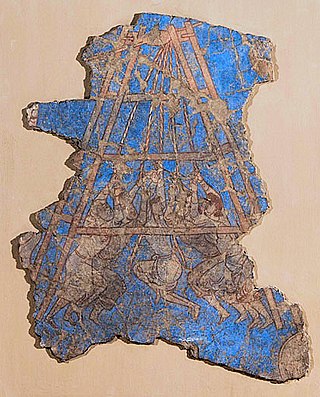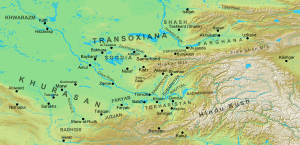Sunpadh was an Iranian nobleman from the House of Karen, who incited an uprising against the Abbasid Caliphate in the 8th century.

Greater Khorāsān or Khorāsān or Khurāsān is a historical eastern region in the Iranian Plateau between West and Central Asia that encompasses western Afghanistan, northeastern Iran, the eastern halves of Turkmenistan and Uzbekistan, western Tajikistan, and portions of Kyrgyzstan and Kazakhstan.

The First Perso-Turkic War was fought during 588–589 between the Sasanian Empire and Hephthalite principalities and its lord the Göktürks. The conflict started with the invasion of the Sasanian Empire by the Turks and ended with a decisive Sasanian victory and the reconquest of lost lands.

Chaghaniyan, known as al-Saghaniyan in Arabic sources, was a medieval region and principality located on the right bank of the Oxus River, to the south of Samarkand.
Hulwan was an ancient town on the Zagros Mountains in western Iran, located on the entrance of the Paytak Pass, nowadays identified with the town of Sarpol-e Zahab.
Abū Ḥafṣ Qutayba ibn Abī Ṣāliḥ Muslim ibn ʿAmr al-Bāhilī was an Arab commander of the Umayyad Caliphate who became governor of Khurasan and distinguished himself in the conquest of Transoxiana during the reign of al-Walid I (705–715). A capable soldier and administrator, he consolidated Muslim rule in the area and expanded the Caliphate's border to include most of Transoxiana. From 705 to c. 710, he consolidated Muslim control over the native principalities of Tokharistan and conquered the principality of Bukhara, while in 710–712 he conquered Khwarizm and completed the conquest of Sogdiana with the capture of Samarkand. The latter opened the road to the Jaxartes valley, and during the last years of his life Qutayba led annual campaigns there, extending Muslim control up to the Fergana Valley and parts of Chinese Turkestan.
The NahrawanCanal was a major irrigation system of the Sasanian and early Islamic periods in central Iraq, along the eastern banks of the Tigris and the lower course of the Diyala River. Created in the 6th century, it reached its peak under the Abbasid Caliphate, when it served the main water supply for the Abbasid capital of Baghdad, while the regions irrigated by it served as the city's main breadbasket. Its destruction and progressive abandonment from the mid-10th century onwards mirror the Abbasid Caliphate's decline.
Naṣr ibn Sayyār al-Lāythi al-Kināni was an Arab general and the last Umayyad governor of Khurasan in 738–748. Nasr played a distinguished role in the wars against the Turgesh, although he failed to decisively confront the rebellion of al-Harith ibn Surayj in its early stages. Although respected as a soldier and a statesman, he owed his appointment as governor more to his obscure tribal background, which rendered him dependent on the caliph. His tenure was nevertheless successful, as Nasr introduced long-overdue tax reforms that alleviated social tension and largely restored and stabilized Umayyad control in Transoxiana, which had been greatly reduced under the Turgesh onslaught. His last years were occupied by inter-tribal rivalries and uprisings, however, as the Umayyad Caliphate itself descended into a period of civil war. In 746 Nasr was driven from his capital by Ibn Surayj and Juday al-Kirmani, but returned after the latter fell out among themselves, resulting in Ibn Surayj's death. Preoccupied with this conflict, Nasr was unable to stop the outbreak and spread of the Abbasid Revolution, whose leader, Abu Muslim, exploited the situation to his advantage. Evicted from his province in early 748, he fled to Persia pursued by the Abbasid forces, where he died on 9 December 748.

The Muslim conquest of Transoxiana or Arab conquest of Transoxiana were the 7th and 8th century conquests, by Umayyad and Abbasid Arabs, of Transoxiana, the land between the Oxus and Jaxartes rivers, a part of Central Asia that today includes all or parts of Uzbekistan, Tajikistan, Kazakhstan, and Kyrgyzstan.

The Round City of Baghdad is the original core of Baghdad, built by the Abbasid Caliph al-Mansur in 762–766 CE as the official residence of the Abbasid court. Its official name in Abbasid times was City of Peace. The famous library known as the House of Wisdom was located within its grounds.
Khazim ibn Khuzayma al-Tamimi was a Khurasani Arab military leader. One of the early supporters of the Abbasid da'wa in Khurasan, he played a major role in the Abbasid Revolution against the Umayyads, and then spent the next two decades suppressing revolts across the Caliphate. As one of the main figures of the Khurasaniyya, the main power base of the Abbasid regime, he cemented his family in a position of power and influence: his sons would play an important role in the affairs of the Caliphate over the next decades.
Abu Hatim al-Harith ibn Surayj was an Arab leader of a large-scale social rebellion against the Umayyad Caliphate in Khurasan and Transoxiana. Harith's rebellion began in 734 and represented the grievances of both the local Arab settlers as well as the native Iranian converts, who were not recognized as equal to the Arab Muslims, against the Umayyad regime. Harith based his revolt on religious grounds and won over a large part of both the Arab settlers and the native population, but failed twice to capture the provincial capital of Marw. The rebellion was finally suppressed by Asad ibn Abdallah al-Qasri in 736. Along with a few supporters, Harith escaped capture and allied himself with the heathen Türgesh. Harith accompanied the Türgesh qaghan Suluk in his invasion deep into Arab-held territory, which was decisively beaten back in the Battle of Kharistan in 737. With Türgesh power collapsing thereafter, Harith remained in Transoxiana supported by the native princes. Asad's successor, Nasr ibn Sayyar, campaigned against Harith and his native supporters, but eventually, hoping to use him to bolster his position in the Arab inter-tribal rivalries, Nasr secured for Harith a pardon from the Caliph. Harith returned to Marw in 745. Soon however he raised a sizeable armed force and challenged Nasr's authority, until he was killed in a clash with his ally Juday al-Kirmani in 746. His revolt weakened Arab power in Central Asia and facilitated the beginning of the Abbasid Revolution that would overthrow the Umayyads.
Asad ibn Abdallah al-Qasri was a prominent official of the Umayyad Caliphate, serving twice as governor of Khurasan under the Caliph Hisham ibn Abd al-Malik. The descendant of a prominent Arab family, he was the brother of Khalid al-Qasri, the powerful governor of Iraq for most of Hisham's reign. Asad's first tenure as governor in 724–727 came in the wake of the "Day of Thirst", a severe defeat at the hands of the Türgesh Turks in Transoxiana. Asad tried to reconcile the local Soghdians to Muslim rule, initiated tax reforms to address the grievances of the native converts to Islam, and enjoyed good relations with many local nobles, who began to convert to Islam under his influence. His military expeditions during his first tenure were targeted mainly against restive local princes, avoiding a direct confrontation with the Türgesh.
Qūmis, was a province in pre-Islamic Persia, lying between the southern Alborz chain watershed and the northern fringes of the Dasht-e Kavir. During the Sasanian Empire, it designated the area lying between the provinces of Ray and Hyrcania (Gurgan) and was part of the province of Padishkhwargar.

Marw-Rud or Marw al-Rudh, locally used to be known by the older variants Marwarudh (مروروذ) and Marrudh (مروذ), was a medieval settlement in Khurasan. It was also known as Marw-i Kuchik to distinguish it from the nearby Marw al-Shahijan or Greater Marw.

ʿAbd Allāh ibn Khāzim al-Sulamī was the Umayyad governor of Khurasan between 662 and 665 and again in late 683, before becoming the nominal Zubayrid governor of the same province between 684 and his death.

The Khuld Palace was one of the principal caliphal palaces in Baghdad during the early Abbasid Caliphate.
The Hasani Palace was the first caliphal palace to be built in East Baghdad, and the main residence of the Abbasid caliphs in the city during the 9th and 10th centuries. As such it formed the nucleus around which a large complex of palaces and gardens emerged, that would be the residence of the Abbasid caliphs until the Sack of Baghdad by the Mongols.

Jarjarāyā was a city of medieval Iraq, surrounded by a meander of the Tigris. Capital of the district of Lower Nahrawan, it was inhabited by Persian nobles, according to Ya'qubi. This has been taken to assume that Jarjaraya was founded in the Sasanian period, if not earlier. By the time of Yaqut al-Hamawi in the early 1200s, however, the town was in ruins. Archaeological evidence suggests that the site was abandoned by the end of the Abbasid period.
Yusuf al-Barm was a rebel leader against the Abbasid Caliphate in Khurasan in the 770s.










